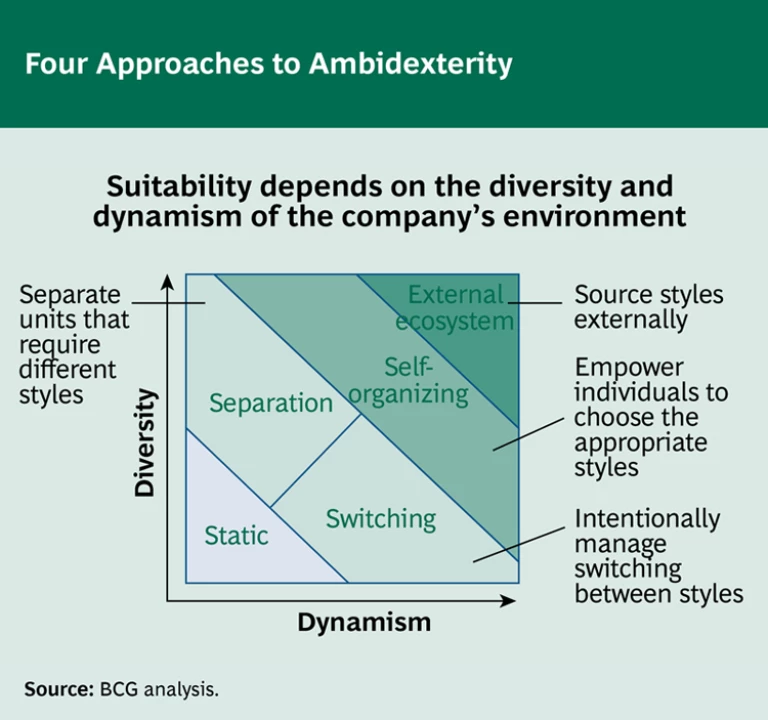“To deliver growth among the best in our industry, we’re strengthening our core business, renewing our focus on discontinuous innovation, and implementing a $10 billion productivity program.”
—Procter & Gamble, 2012 Annual Report
Managers today face an apparent contradiction. On one hand, austerity in the developed world and intense competition push them to cut costs and drive efficiencies. On the other, the increasing pace of change means they need to emphasize innovation.
Resolving this contradiction requires ambidexterity—the ability to both explore new avenues and exploit existing ones. Companies need ambidexterity when operating in diverse environments that require different styles of strategy simultaneously, or in dynamic environments that require them to transition
The need to develop ambidexterity is widely acknowledged: in a recent BCG survey of 130 senior executives of major public and private companies, fully 90 percent agreed that being able to manage multiple strategy styles and transition between them was an important capability to develop. But this aspiration is hard to realize. Exploration and exploitation require different ways of organizing and managing. Exploration is facilitated by long-term targets, a flexible and decentralized structure, and a culture of autonomy and risk taking, while exploitation typically requires short-term targets, centralization, standardization, and discipline in execution. And switching between them is difficult because managers tend to emphasize what delivered success yesterday. In the words of BCG’s founder, Bruce Henderson, “Success in the past always becomes enshrined in the present by the over-valuation of the policies and attitudes which accompanied that success.”
3M, a company renowned for its culture of innovation, experienced the exploration-exploitation tradeoff in the early 2000s, when it introduced Six Sigma practices in an effort to boost productivity. While the company’s productivity did indeed increase, the same practices reduced 3M’s ability to innovate, as evidenced by a fall in the proportion of revenues from new products.
Ambidexterity is therefore rare: a recent BCG study of the financial performance of approximately 2,000 publicly listed U.S. companies found that only about 2 percent consistently outperformed their industry in both turbulent and stable periods. But ambidexterity is becoming an increasingly critical asset as the diversity and dynamism of business environments rise. The growing economic importance of emerging markets, for example, is expanding the range of environments that companies need to operate in. At the same time, technological change is overturning existing products and business models at an increasing rate. It took the PC approximately 15 years to go from 10 percent market penetration to 40 percent; it took the Internet 5 years and smartphones fewer than 3.
Picking the Right Approach to Ambidexterity
Companies in stable, simple environments do not require ambidexterity—they can thrive by emphasizing operating efficiency. But most others will need to pursue it. Ambidexterity can be achieved through four distinct approaches: separation, switching, self-organizing, and external ecosystem. (See the exhibit.)
Separation is the simplest, most common approach to achieving ambidexterity and is appropriate for companies facing environments that are diverse but relatively stable over time. It involves structurally separating units that need to deploy different strategy styles. A company might, for example, separate its mature business, which requires efficiency and disciplined execution, from its emerging business, which needs to be innovative and flexible.
There are many well-known examples of this approach. In 1943, Lockheed Martin, faced with the task of creating an advanced fighter while at the same time mass producing its established Hudson bomber, opted to create two fully separate units (marking the birth of what would become the company’s famous Skunk Works), each with its own physical location, resources, and culture. Similarly, in 2000, IBM separated its established businesses, where a focus on execution and operating metrics was appropriate, from its emerging-businesses unit, which the company used to explore new opportunities and markets.
But separation does not always work, because a company’s structure tends to be semipermanent while its environment may not be. Separation also creates barriers that prevent information and resource flow among units, potentially impeding their ability to change emphasis or style when required. Companies such as fashion retailer Zara and industrial conglomerate GE have reduced separation when operating in dynamic environments. At Zara, design and manufacturing work collaboratively to shorten new-product cycles in a highly dynamic industry. GE has in-sourced manufacturing of some of its high-end refrigerators and other consumer appliances and increased integration of design and manufacturing, allowing the business to shift quickly from creating new designs to exploiting them in the market.
Dynamic environments require instead a switching approach. Here, a company changes its style over time as its environment changes, similar to the way in which new companies evolve. Initially, an organization must deploy an exploratory style as it looks for a breakout product, service, or technology. Over time, however, it must transition to a more exploitative style in order to scale up and secure a profitable market position. Amazon was able to rapidly switch from exploration to exploitation. In only two years, it went from exploring (out of Jeff Bezos’s garage) the use of the Internet for retailing to exploiting and industrializing its operations, opening its first distribution center, and going public.
Many larger companies also deploy switching strategies. The glassmaker Corning was able to rapidly transition from exploring ways to make superstrong glass films to delivering its Gorilla Glass product, now found in more than a billion mobile devices worldwide.
Switching requires resources and information to flow readily across organizational boundaries. This can be problematic because when senior management makes the decision to change styles, some organizations respond slowly, resource conflicts erupt between units, and staff resist the change, fearful of the consequences of moving to a new project that might not succeed. Startups are particularly good at switching—but that does not mean that a similar culture cannot exist in a large organization.
When a company needs to deploy multiple styles simultaneously—and the styles are changing over time—a self-organizing approach is called for, since managing the switching process in a top-down manner becomes complex and infeasible. Here, individuals or small teams can choose for themselves which style to employ and switch between them over time. Companies achieve self-organizational capabilities by breaking the organization down into small units and creating individualized performance contracts. Each unit negotiates with its peers according to local rules of interaction established by the center and deploys whatever style it thinks will maximize its performance.
Chinese consumer-goods company Haier successfully employs a self-organizing approach. Seeking to improve its ability to deliver customer value, the global conglomerate flattened its organization structure and developed 2,000 self-governing units. Each unit functions like an autonomous company, with its own profit-and-loss statement, operations, innovation program, and motivation. This approach has helped Haier go from near bankruptcy in the 1980s to market leadership today.
A self-organizing approach has its drawbacks, however. It incurs significant costs from duplication, the lack of scale of the individual units, and the additional costs of enforcing the local rules of interaction and keeping score. Hence the approach is only appropriate in highly diverse and dynamic environments.
In the most complex cases, companies may need to orchestrate a diverse ecosystem of external parties in order to source the strategy styles they require. This is the external ecosystem approach. Apple has used it with great success in the smartphone arena, where winning requires multiple strategy styles. For example, content creation and app development require rapid adaptation to changing consumer needs and fast-moving competition, while component manufacturing and assembly are scale intensive and require a more classical approach. The industry is also highly dynamic. Rather than trying to deploy all strategy styles itself, Apple chooses to shape and orchestrate an ecosystem of companies that exercise the strategy styles it needs. It achieves this by creating common platforms, such as the iTunes Store, that are beneficial to all ecosystem participants.
Companies need to employ an external ecosystem approach when the environment is extremely diverse and dynamic and it is hard to produce the required range of styles internally. This approach is only appropriate in the most complex cases because of the high costs and risks of cooperation—the cost of building platforms such as iTunes, the profits the company must give away to incentivize third parties to participate, and the risks associated with dilution of control over the company’s operations.
The Path to Ambidexterity
To build ambidexterity, companies must understand the diversity and dynamism of their environment and choose and implement the appropriate approach. Each approach requires a different set of organizational interventions and implies a different role for the center.
Where separation is required, identify scale-driven (that is, exploiting) and innovation-driven (that is, exploring) business units and set clear boundaries between them by separating objectives, resources, talent, and risk management approaches. The role of the center here is to set and maintain these boundaries and provide centralized services as efficiently as possible.
Where switching is needed, design incentives to break down silos and encourage collaboration, and create a culture of flexibility among managers. The role of the center is to create alignment between strategy style and environment and to modulate style over time. Central functions like HR and IT should be flexible enough to meet the changing needs of individual groups over time.
Where self-organizing is called for, break down business units and functions into small groups and set local rules of interaction for how units negotiate with each other and how performance will be assessed. Here the role of the center is smaller: its function is to design and implement the local incentives from which the organization will self-assemble.
Where an external ecosystem is required, create platforms that are attractive to potential partners, develop a vision around which to orchestrate parties, and rearrange the corporate center as coordinator of the external ecosystem.
Although ambidexterity is tough to master, it is an increasingly critical capability for managers struggling with the apparent paradox of exploring and exploiting. The imperative to achieve ambidexterity will only rise as technological change and economic turbulence increase the diversity and dynamism of the business environment. Far-sighted companies are beginning to build organizations that can both explore and exploit. Managers must act decisively or risk being overtaken by ambidextrous rivals.










